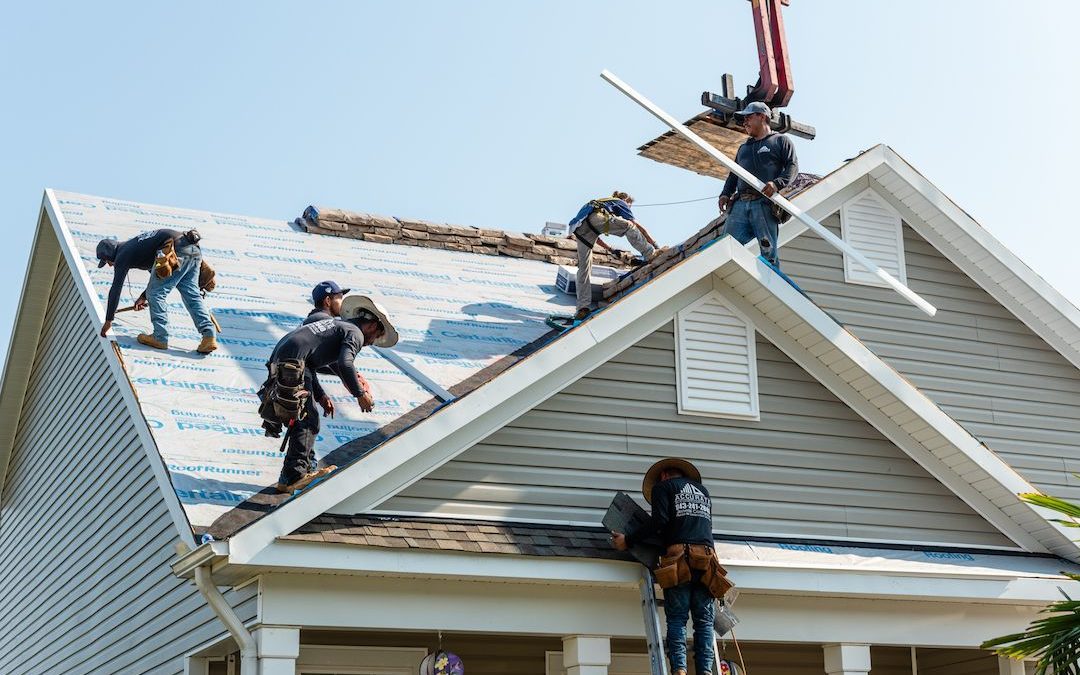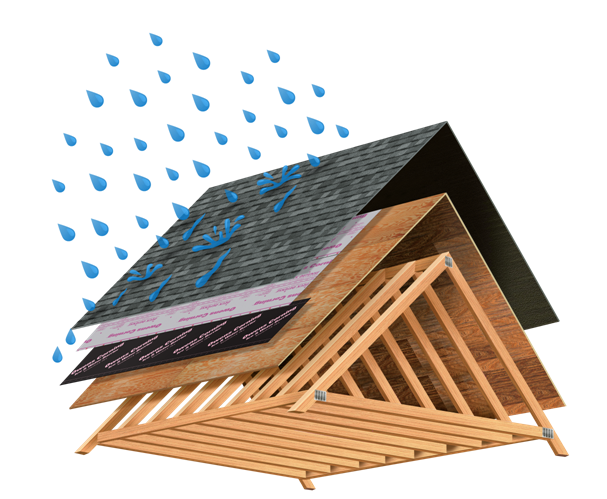Usual Problems That Can Impact Your Roofing and How to Address Them
Roofing concerns can develop from different factors, affecting the integrity of a home. roofing pleasant hill mo. Usual problems include leakages, missing tiles, and poor ventilation. Property owners commonly overlook these concerns up until they rise, leading to even more considerable damages. Understanding the causes and services is necessary for maintaining a roof's durability. What steps can be required to stop these problems from becoming expensive repair work?
Roofing Leakages and Their Causes
Although roof leakages can emerge from numerous resources, comprehending their main reasons is crucial for effective avoidance and repair service. One typical factor is the build-up of debris in seamless gutters and valleys, which can obstruct water flow and cause merging. In addition, inappropriate flashing around chimneys, vents, and skylights can produce weak factors, permitting water to penetrate. Aging roof covering materials likewise play a considerable role; as roofing systems age, they might end up being fragile and shed their efficiency at repelling moisture. Moreover, ice dams can create during winter season, causing water to back up under tiles and leak right into the home. Poor ventilation can lead to moisture accumulation in the attic, which might jeopardize the roofing system framework over time. Recognizing these reasons can aid homeowners take proactive steps to keep their roof coverings and stop pricey repair services.
Missing Out On or Harmed Tiles
Numerous property owners deal with concerns with missing out on or harmed tiles, which can greatly endanger the honesty of a roofing. Roofing shingles can come to be dislodged or wear away because of severe weather problems, age, or bad installment. This damages usually causes leakages, increased energy costs, and possible architectural troubles if not resolved promptly.To remedy this concern, home owners ought to carry out regular inspections of their roof coverings, specifically after serious tornados. Recognizing missing out on or damaged roof shingles early can prevent additional complications. If shingles are discovered to be missing, changing them without delay is crucial. For minor damage, such as fractures or curling, using roof covering cement can supply a short-term fix.In cases of extensive shingle damage, a complete roof replacement might be necessary. Consulting with a specialist professional roofer is a good idea to analyze the level of the damage and suggest the finest program of action to assure the roof's longevity and efficiency.
Poor Roofing System Air Flow
Poor roof covering air flow can bring about a range of issues, consisting of excessive heat buildup and moisture build-up. House owners might see signs such as deformed tiles, peeling off paint, or mold growth as indications of insufficient air flow. roofing contractor in pleasant hill. Addressing these problems with effective air flow solutions can greatly boost the roofing's lifespan and overall home convenience
Indicators of Poor Ventilation
How can one identify the signs of poor roofing air flow? Home owners might notice numerous indicators that indicate bad ventilation in their roof covering system. One usual sign is the visibility of excessive warm in the attic room, usually leading to raised power prices as a/c systems function more difficult to cool down the home. Furthermore, wetness build-up might manifest as mold or mold, which can jeopardize both the roofing system and indoor air quality. Deforming or staining of roof materials can additionally indicate inadequate air movement. Ice dam formation throughout wintertime months might indicate trapped warmth due to inadequate ventilation. Recognizing these indicators early can help homeowners address ventilation problems before they intensify right into more substantial roof covering issues.
Solutions for Improved Air Flow
To enhance roof covering ventilation, home owners can implement several efficient remedies that promote better air movement and decrease heat build-up. One of the most efficient techniques is to mount ridge vents, which permit warm air to get away from the optimal of the roofing system. Additionally, soffit vents can be mounted along the eaves to attract cooler air right into the attic room. Including turbine vents or powered attic room ventilators can even more enhance circulation, particularly in warm climates. Home owners need to also make particular that insulation is correctly installed, as it can block air flow otherwise positioned correctly. Routine evaluations and maintenance, consisting of cleaning debris from vents, are important to preserving efficient air flow and extending roof life.
Tornado Damages and Its Impact
Tornados can trigger numerous kinds of damages to roofs, greatly affecting their integrity and long life. Recognizing signs of roof problems promptly is vital for reliable repair work and maintenance. Understanding these facets can help house owners guard their properties versus storm-related damage.
Kinds Of Tornado Damage
Severe climate events can Visit Website trigger numerous kinds of damages to roofs, greatly impacting the stability of a home. High winds can lift floor tiles or shingles, leading to subjected locations that may enable water infiltration. Hail can create dents, splits, or punctures in roof materials, compromising their protective capabilities. Hefty rainfall can exacerbate existing susceptabilities, resulting in leaks and water damages. In addition, snow build-up can cause structural stress and anxiety, potentially causing cave-ins if not appropriately handled. Particles from tornados, such as fallen branches or uprooted trees, can cause substantial physical damages. Understanding these kinds of storm-related damages is necessary for house owners to take prompt activity and assure the long life of their roof covering systems.
Signs of Roofing Issues
Many homeowners may not right away see the indicators of roof covering problems, a number of signs can suggest tornado damage and its impact. Noticeable roof shingles that are split, missing, or crinkled frequently suggest that the roof has been endangered. House owners must likewise be watchful for granules in rain gutters or around the home, as this can signify shingle deterioration. In addition, staining or water discolorations on walls and ceilings may suggest leaks stemming from storm-related damage. Sometimes, the existence of mold and mildew or mold can suggest long term wetness exposure, further emphasizing the urgency of attending to roof covering concerns. Drooping or unequal rooflines can recommend architectural troubles that might have developed after serious weather events, calling for prompt evaluation.

Repair Work and Upkeep Tips
Resolving roofing issues without delay can substantially reduce more damage and extend the life expectancy of a roofing system. Tornado damage, such as missing roof shingles or leaks, needs immediate interest to stop water seepage and architectural compromise. Homeowners ought to conduct regular assessments after serious weather condition occasions to determine possible damage. If visible issues develop, such as drooping or staining, it is suggested to get in touch with a professional roofing contractor for an extensive analysis. Short-term repairs, like tarpaulins, can give short-term alleviation up until irreversible repair services are made. Routine maintenance, consisting of cleansing rain gutters and cutting overhanging branches, can also decrease the threat of future storm damages. By prioritizing these repair work and upkeep ideas, house owners can boost the durability and efficiency of their roof covering systems.
Mold and Mold Development
When dampness accumulates on roofing products, it develops a setting favorable to mold and mildew growth. This biological invasion can endanger the architectural integrity of the roof covering and cause significant health concerns for passengers because of the launch of spores into the air. Usual reasons of moisture accumulation include poor ventilation, my site leakages, and extended direct exposure to humidity.To battle mold and mildew and mold, property owners ought to consistently evaluate their roofs for indications of water damage or staining. Executing proper air flow systems helps in reducing humidity levels, while promptly dealing with leaks is crucial. Cleansing the roof with proper mold-removal solutions can likewise work. In extreme situations, substitute of affected roof products might be needed. Regular upkeep and watchfulness can stop mold and mildew and mold from coming to be a relentless issue, making sure both the durability of the roofing system and the wellness of those living under it.
Buildup of Debris
Mold and mildew and mildew are not the only hazards to roof covering products; the buildup of particles can additionally posture substantial risks. Leaves, branches, and other raw material can gather on the roof, causing different concerns. When particles blockages rain gutters and downspouts, it avoids proper water drainage, which can result in water merging and possible leaks. Furthermore, entraped dampness can develop a setting conducive to mold and mold growth, further weakening roof covering materials.Regular upkeep is crucial to mitigate these dangers. House owners ought to regularly examine their roof coverings, especially after tornados or high winds, to remove any kind of collected particles. Cleaning rain gutters and making sure that downspouts are clear will help keep appropriate drain. Sometimes, hiring a professional solution may be advisable to guarantee secure and complete cleaning. By addressing debris accumulation immediately, the lifespan of the roof can be expanded, protecting the home from more damage.
Aging Roof Covering Materials
Aging roofing system materials present a significant obstacle for homeowners, as their damage can bring about serious structural problems. roofing contractor in pleasant hill. Over time, direct exposure to extreme climate condition, UV rays, and temperature level variations speeds up wear and tear, diminishing the roofing system's effectiveness. Asphalt roof shingles may break, crinkle, or lose granules, while metal roof coverings can create rust and deterioration. These problems not just jeopardize the roof covering's honesty yet can also cause leaks and water damages inside the home.To address aging roof materials, regular evaluations are crucial. Property owners should search for signs of wear, such as missing shingles or staining. Regular maintenance, consisting of cleansing gutters and replacing broken materials, can expand the lifespan of the roof. In instances of extreme wear and tear, a total roofing system replacement might be needed. Consulting with a professional roof covering specialist can give an exact analysis and ideal options customized to the details demands of the home
Often Asked Inquiries
Just How Can I Inform if My Roofing System Needs Substitute?
To establish if a roof covering requires replacement, one must examine for substantial wear, missing roof shingles, leakages, or sagging. Consulting a roof specialist can offer an accurate analysis and advice on necessary activities for safety and security and long life.
What Are the Signs of a Roof Service Warranty Problem?
Indicators of a roofing system warranty issue include noticeable leaks, significant wear, or damage not brought on by exterior variables. Homeowners should document concerns and consult the guarantee terms to establish eligibility for replacements or repairs.
Exactly how Often Should I Get My Roof Covering Evaluated?
Normal roof covering inspections are suggested at the very least twice a year, preferably in spring and loss. This aggressive method helps identify prospective problems early, ensuring the roofing stays in excellent problem and prolonging its lifespan.
Can I Do My Own Roofing Repairs?
The private pondered the possibility of doing their own roof covering fixings. While some small tasks could be workable, care is advised; incorrect fixings can cause substantial issues, calling for specialist help for safety and security and efficiency.
What Is the Average Life-span of Various Roof Materials?
